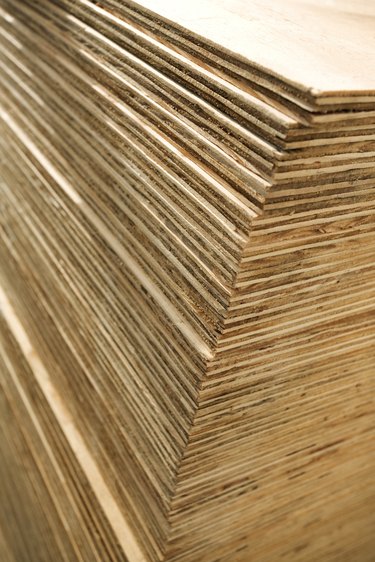
Plywood, oriented strand board (OSB) and particleboard are all examples of laminated wood. Lamination is the process of creating a rigid product by compressing thin sheets or small pieces of wood together to form a larger piece, using glue. Manufacturers of laminated wood products use pressure and heat to compress the small wood pieces into the large sheets found in nearly every new home. Laminated wood products are very strong, but they are not indestructible. Delamination occurs when the glue that holds the wood pieces together fails.
Signs
Video of the Day
The first sign of delamination is usually either a lump or a bubble on the surface of plywood or another laminated sheet material, or expansion along the edges of the sheets. As the small wood pieces that make up the sheet loosen, they swell and pull away from each other, causing the sheet to expand. When delamination is extensive, the sheet products lose their structural integrity, resulting in a spongy subfloor, weak roof sheathing or bulging exterior siding. Delamination may also occur in cabinets and other furniture products that are made from finish-grade laminated wood.
Video of the Day
Problems
Mild or minimal delamination might not compromise the integrity of the structure. Builders expect a small degree of delamination, and they make provisions for it by spacing plywood sheets 1/8 inch apart when installing boxing on the exterior of the house or sheathing on the roof. Moderate or heavy delamination, however, almost always results in the need to replace the damaged wood.
Causes
Moisture, especially when combined with heat, causes delamination. Water from a leaky window can travel down wall studs and saturate a section of laminated wood used to construct the subfloor. The problem can remain hidden until the homeowner discovers a lump beneath the linoleum or carpeting. A leak need not be present in order for delamination to occur. An unvented attic can become very hot and humid on a summer's day; and if the hot, moist air can't escape, it can penetrate the underside of the roof decking, causing the sheets to delaminate.
Remedies
Repairing leaks, venting the attic and storing laminated wood products indoors is essential, but once wood delaminates to the point that it's soft and spongy, it must be replaced. This typically entails cutting out the delaminated section of wood, such as a damaged area of subflooring around a leaky commode, and replacing it with a new section of the same size.